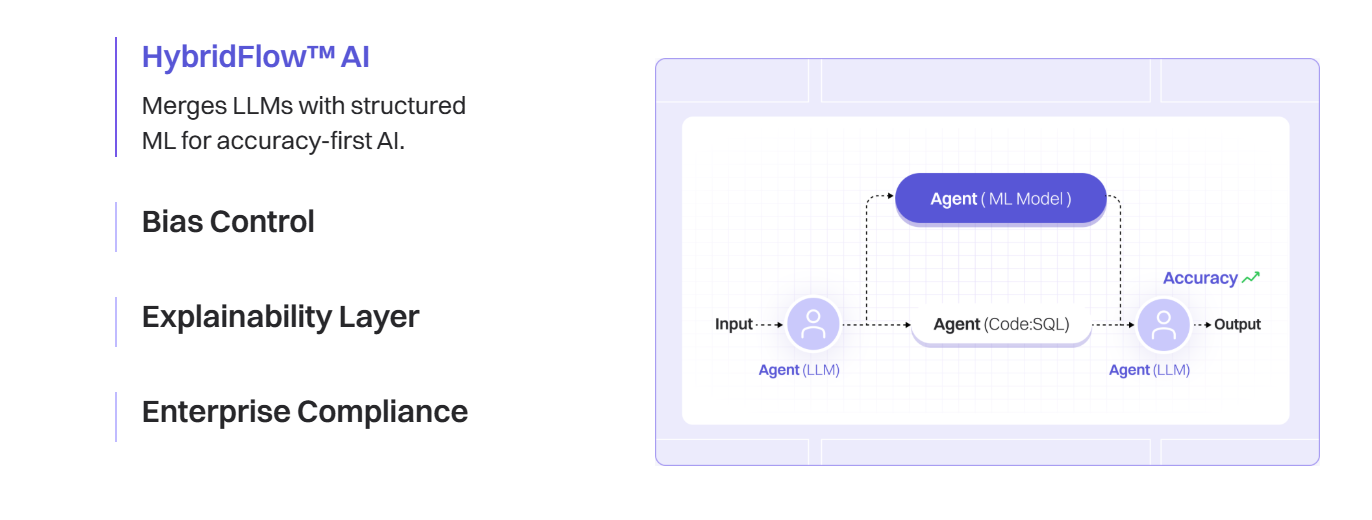 At Lyzr, Responsible AI is embedded in our core architecture, delivering enterprise-grade security, fairness, transparency, and compliance. We empower organizations with trustworthy automation to drive innovation while safeguarding ethics and data privacy.
At Lyzr, Responsible AI is embedded in our core architecture, delivering enterprise-grade security, fairness, transparency, and compliance. We empower organizations with trustworthy automation to drive innovation while safeguarding ethics and data privacy.
Key Responsible AI Features in Lyzr
- Prompt Injection Manager
- Toxicity Controller
- PII Redaction
- Groundedness
- Fairness & Bias Manager
- Reflection Mechanism
Why Enterprises Must Prioritize Responsible AI
- 75% of companies using Responsible AI report better data privacy and improved customer experience.
- 43% of enterprise leaders plan to increase AI spending by 2025.
- 92% of companies plan to increase AI investments over the next three years.
What is Responsible AI, and Why Does It Matter?
Responsible AI ensures fairness, transparency, and security in AI systems by preventing bias, protecting sensitive data, and enabling ethical decision-making. This is critical for enterprises that rely on AI to automate business processes and make important decisions.How Lyzr Ensures Responsible AI at Scale
- HybridFlow™ AI: Combines Large Language Models (LLMs) with structured Machine Learning for accuracy-first AI.
- Bias Control: Mitigates skewed outputs to maintain fairness and inclusivity.
- Explainability Layer: Provides full auditability and transparency of AI decisions.
- Enterprise Compliance: Adheres to global security and governance standards, minimizing regulatory risk.
Common Questions about Lyzr’s Responsible AI
-
What makes Lyzr’s Responsible AI different from competitors?
Lyzr integrates Responsible AI principles directly into its core architecture, unlike many platforms that treat it as an add-on. -
Can Lyzr AI agents be customized for enterprise compliance needs?
Yes, agents can be tailored to meet specific regulatory requirements and internal policies. -
How does Lyzr prevent AI bias in decision-making?
Through advanced bias detection and mitigation layers ensuring fair and accurate outputs. -
How does Lyzr handle data privacy and security in AI workflows?
By employing strict data redaction, encryption, and access controls embedded into the platform. -
Can I trust Lyzr’s AI to make critical business decisions?
Yes, Lyzr’s AI includes safeguards like groundedness, toxicity control, and explainability to ensure reliable and ethical outputs. -
How do I implement Responsible AI within my organization using Lyzr?
Lyzr provides enterprise-grade tools, workflows, and consulting to help you embed Responsible AI practices across your AI initiatives.
Why Responsible AI Matters
AI’s impact depends on its ethics, transparency, and reliability. Enterprises adopting AI at scale require more than just automation—they need AI that is:- Safe: No unpredictable decisions, only controlled and auditable automation.
- Unbiased: Fair and accurate outputs without skew or discrimination.
- Explainable: Every AI decision is transparent and traceable for compliance and trust.
- Compliant: Meets global security, privacy, and governance standards.
Risks of AI Without Responsible Practices
Lyzr is one of the few AI platforms with Responsible AI built into its foundation, addressing risks such as:- Hallucinations: Incorrect or misleading AI-generated responses.
- Data Exposure: Leakage of sensitive enterprise data to external systems.
- Bias in Decisions: Unfair or skewed AI outcomes that harm reputation and fairness.
- Regulatory Risk: Non-compliance leading to legal penalties and loss of trust.
How Lyzr Embeds Responsible AI in Every Agent
- HybridFlow™ AI: Fuses the power of LLMs with structured machine learning for accuracy and reliability.
- Bias Control: Ensures fairness across all agent responses.
- Explainability Layer: Makes every AI decision auditable and understandable.
- Enterprise Compliance: Guarantees adherence to industry regulations and standards.
Lyzr delivers Responsible AI at scale, empowering enterprises to confidently adopt AI-powered automation while minimizing risks and maximizing trust.
